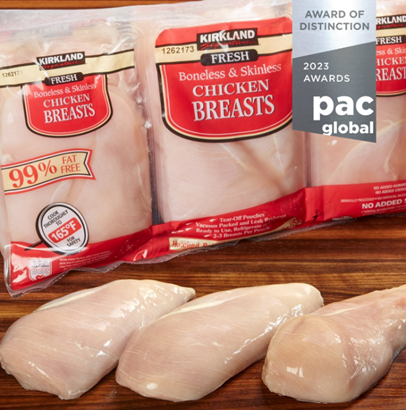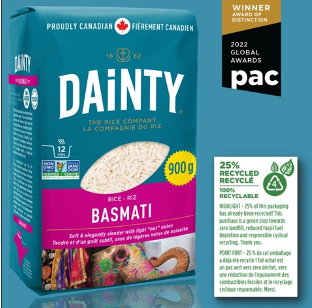The following actions, individually or collectively, will contribute to achieving the outcomes of reducing the environmental impacts of flexible packaging thru the incorporation of recycled content.
Available Courses of Action
- Action 1 – Incorporate Post-Consumer Recycled Content / with Food Contact
- Action 2 – Incorporate Post-Consumer Recycled Content / without Food Contact
Action 1 – Incorporate Post-Consumer Recycled Content / with Food Contact
The incorporation of post-consumer recycled (PCR) content is a leading sustainability strategy, due in large part to the reduced requirement for virgin plastic, the associated reduction in GHG emissions, and the benefits that come with enabling a truly circular economy. For food and produce, a leading challenge remains ensuring that any recycled content incorporated into food packaging meets food contact requirements, if applicable.
The following use case(s) provide examples of where PCR-containing flexible packaging contacting food has been demonstrated.
Use Cases
| Use Case | Innovation | Application | Release to Market |
| Pilgrims Pride | PCR in Formed Film Packaging | Meat and poultry | 2022 |
| Dainty Foods | Block Bottom Bag 25% Post-Consumer Recycled Content | Rice | 2021 |
| Image |  |
|||
| Project | Pilgrims Pride | |||
| Brand(s) | Pilgrims Pride | Packaged Product(s) | Meat and poultry | |
| Market(s) | USA | Release to Market(s) | 2022 | |
| Manufacturer | TC Transcontinental Packaging | Material(s) | Formed films with saddle pack design | |
| Summary |
|
|||
| References | Sustainable Packaging Coalition (SPC) Design for Recycled Content Guide US Plastics Pact PCR Toolkit | |||
| Image |  |
|||
| Project | Dainty Foods | |||
| Brand(s) | Les Ailments Dainty Foods | Packaged Product(s) | Rice | |
| Market(s) | Canada | Release to Market(s) | 2021 | |
| Manufacturer | Emmerson Packaging | Material(s) | PE block bottom bag | |
| Summary |
|
|||
| References | Sustainable Packaging Coalition (SPC) Design for Recycled Content Guide | |||
Action 2 – Incorporate Post-Consumer Recycled Content / without Food Contact
The incorporation of post-consumer recycled (PCR) content is a leading sustainability strategy, due in large part to the reduced requirement for virgin plastic, the associated reduction in GHG emissions, and the benefits that come with enabling a truly circular economy. For food and produce, a leading challenge remains ensuring that any recycled content incorporated into food packaging meets food contact requirements, if applicable. As such, there is increasing interest in considering applications where PCR can be incorporated while avoiding food contact.
The following use case(s) provide examples of where PCR-containing flexible packaging without food contact has been demonstrated.
Use Cases
Use Cases are currently being identified and reviewedSupporting Resources
Useful resources to consider as you explore applying one or more of the above actions to flexible packaging include:
General Information
- PCR Certification
Assocation of Plastic Recyclers (APR)APR provides PCR Certification to support a reliable, robust PCR market. Any plastics reclaimer generating PCR pellet or flake can participate in this program to provide customer assurances in the authenticity of their product.
- The Recycled Material Standard (RMS)
GreenBlue (SPC)The RMS is a voluntary, market-based tool to address some of the challenges faced by the recycling industry in incorporating higher amounts of recycled content into packaging.
Post-Consumer Recycled Content – Food Contact
- Guidelines for using recycled plastics in food packaging: Overview 2023
Health CanadaThese updated guidelines detail common recycling practices, with a focus on mechanical recycling processes as these are considered to represent the greatest potential health concern for food contact applications. They discuss key aspects of the recycling process such as the: limitations of use, source of feedstock (materials to be recycled), efficiency of the recycling process in the removal of chemical contaminants. These guidelines will assist recyclers, manufacturers and sellers of plastic materials in determining the acceptability and use of post-consumer recycled (PCR) plastics in food packaging applications.
Post-Consumer Recycled Content – Retailer Guidance
- Walmart Recycling Playbook 2021
WalmartThe Walmart Playbook helps companies in setting recyclable and recycled content goals for their packaging.